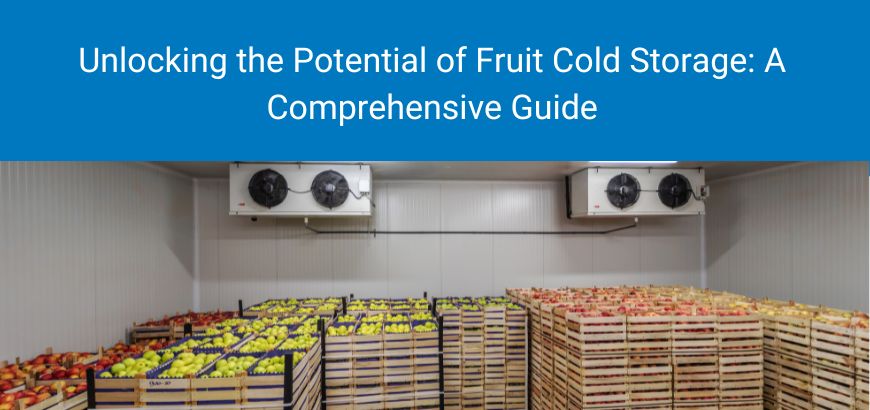Unlocking the Potential of Fruit Cold Storage: A Comprehensive Guide

Admin
August 22, 2023


August 22, 2023

Once a crop is harvested, improving its quality is almost impossible—improper handling and storage results in about 10 to 40% of losses in horticultural crops. Appropriate storage conditions including temperature and humidity are required to maintain the quality and extend the shelf-life or storage life. This is where cold storage has emerged as the primary method for extending the shelf-life of fruits.
This comprehensive guide will dive into the intricacies of fruit cold storage, shedding light on its importance, temperature guidelines, the process, and its impact on fruit quality and business.
Fruits are living tissues that breathe or respire even after they are harvested. In fact, their physiology and composition change after harvest. They continue to ripen—cellular breakdown and senescence are unavoidable. However, with the right storage conditions, the process can surely be delayed.
Here are some of the benefits of using cold storage for fruits and vegetables.
Usually, fruits need low temperatures and high relative humidity to slow down respiration and metabolic transpiration rates. This helps in reducing water loss and maintaining food quality and value.
There are several types of cold storage facilities used for storing fruits and each one has been designed to meet specific needs. Here are some examples.
Usually, it is recommended that temperate fruit crops be stored at near-freezing temperatures of 0 to 1°C. Whereas fruit crops of tropical or subtropical origin must be kept at higher storage temperatures of 7 to15°C. These conditions are required to avoid any losses due to chilling injury.
There is no single recommendation for temperature for cold storage of all fruits. Usually, the climate of the area, maturity at the time of harvest, and the season of the harvest are some of the factors in determining the optimum temperature for storage.
Also, if the storage temperature is too low, there is a risk of freezing and chilling injury. In fact, too low temperature can be as damaging as too high. Freezing will occur below 32℉ but the occurrence of injury will depend on the commodity or fruit. Freezing injury can lead to loss of rigidity, water soaking, and softening. However, injury can be reduced if the produce is warmed up gradually to optimum storage temperature and is not handled during that thawing period.
Image source: Tree Fruits
Transpiration rates (water loss) from the produce are determined based on the moisture content in the air or relative humidity. At high relative humidity, the produce is able to maintain weight, flavour, appearance, texture, and quality while reducing the juiciness, wilting, and softening.
Image source: Storage Conditions: Fruits and Vegetables
Image source: Storage Conditions: Fruits and Vegetables
Ideally, it is advisable to maintain a temperature near 32ºF (0ºC). For fruit varieties that are chilling-sensitive, temperatures should be maintained in the range of 36 to 38ºF (2 to 3ºC). Fans should be operable to maintain air circulation and high humidity levels will reduce water loss and fruit shriveling.
Here is your step-by-step guide on the process of cold storage.
When it comes to fruit quality and business operations, cold storage can make a huge difference. Cold storage helps maintain the value and quality of the produce by preventing ripening and spoilage. This means not only do consumers receive fresh, high-quality produce but also results in reduced wastage. Farmers and businesses can, thus, improve their profitability.
Additionally, cold storage facilities allow for effective storage and transportation of fruits for the long haul. This means businesses can expand into newer markets and offer their customers a wide variety of fruits around the year.
Fruit cold storage is a vital part of the food industry and plays a key role in maintaining quality and value, reducing wastage, and improving operations and accessibility. As the consumer demand for high-quality fruits continues to grow, energy-efficient and effective cold storage will continue to dominate the cold chain infrastructure.
Whether you are a farmer, distributor, or retailer, get in touch with Rinac to meet all your fruit cold storage needs.